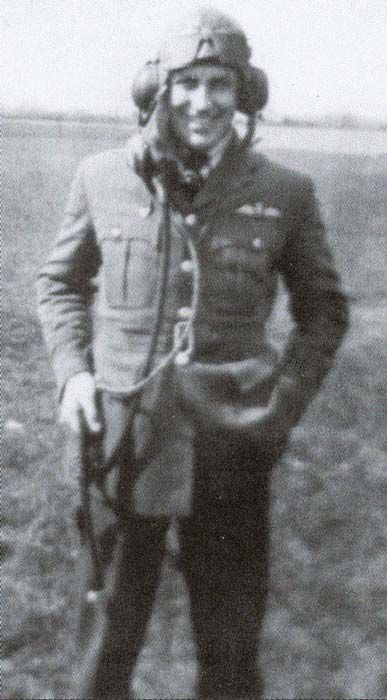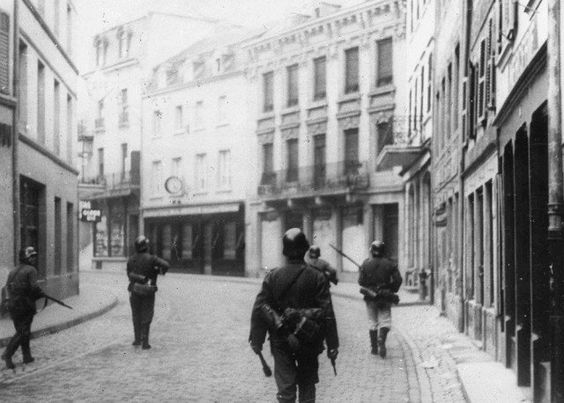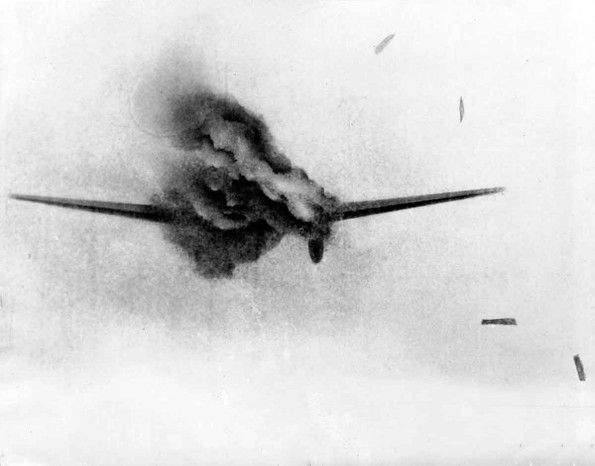Thursday 23 May 1940
 |
| Photographed by their commander, Erwin Rommel, in a Fieseler Storch, this shot shows the 7th Panzer Division, advancing from Arras toward Rouen. 23-24 May 1940. |
The Allies have been holding on the Scheldt River line, but today that cracks. The Germans cross the river and seize Allied supply depots. The BEF goes on half-rations as a result. Ghent falls to the German 18th Army.
General Guderian in charge of XIX Corps in the Channel Ports region is convinced that the only remaining threat is that the British BEF will manage to escape. He orders an immediate assault by the panzers on the fly without waiting for the infantry to catch up. The Allies send 18 French Latecoere seaplanes to bomb the bridges between the Somme and Boulogne to slow Guderian up. The entire scene is a picture of mass confusion, with units intermingled, enemy forces locked into an "embrace," and nobody quite sure where the front is.
The panzers of 2nd Panzer Division are pressing against Boulogne. At 10:00, it attacks from the south and forces the Irish Guards back into town. The Allies in the port have radio problems and lose communications with headquarters. They are told at noontime by an arriving destroyer, HMS Vimy, that they are expected to hold at all costs. However, by 18:00, the order comes to evacuate.
The Royal Navy sends six destroyers to take off as many men from Boulogne as possible. They lose two destroyers, both French, the Jaguar and Drage, but take off 4,360 men. There is a highly unusual land/naval confrontation between the German ground troops, with the Germans firing artillery and tank shells at the British ships. A Panzer IV and one of the destroyers gets into an odd exchange in which the panzer sinks the ship. The panzer crew gets the right to paint a rare "ship" kill on their turret. Overall, though, the British warships provide an extremely effective port defense as they complete the evacuation, though several of the Royal Navy ships are badly damaged. The captains of both HMS Keith and HMS Vimy are killed.
The German 1st Panzer Division is advancing up the Pihen-Les-Guînes road (the Omer road) toward Gravelines. Fierce local battles erupt between the British 3rd Royal Tank Regiment, the 30th Motor Brigade and the panzers, with the British troops forced back into Calais. The 1st Panzer Division, which would have occupied Calais if weakly defended, decides to bypass the port and continue on toward Gravelines/Dunkirk.
The 10th Panzer Division secures the high ground near Calais, while the British 30th Infantry Brigade arrives to help with the defense there. The entire area is a scene of massive confusion, with random British and German units often taking the same roads and one side or the other mistaking the enemy as being friendly forces. The Germans are within sight of Calais, but their line is not continuous, and formations on both sides pass through enemy lines here and there. Tanks of the 10th PD are able to bombard Calais from their position on the overlooking hills.
General Rommel's 7th Panzer Division has been sitting before Arras for three days, and his patience pays off. Early in the morning, Lord Gort issues an order for the British to evacuate the city. Lord Gort has no faith in French promises of counterattacks or strategies in the area. Rommel's panzers head west toward Rouen.
The French mount local attacks near Peronne and Amiens that accomplish little.
General Gaston Billotte, former commander of 1st Army Group, passes away. He has been in a coma since a car accident on 21 May.
European Air Operations: While the RAF fighters have almost all been withdrawn across the channel, they at least are operating from established bases and, at least temporarily, have an advantage along the coast.
Air operations over Boulogne are intense. RAF fighters are needed elsewhere, and the Luftwaffe has free reign over the port for most of the day. The RAF fighters finally arrive at 19:20.
The Luftwaffe bombs French destroyer Orage and sinks it.
The Luftwaffe catches French destroyer Jaguar, which has been damaged by Kriegsmarine S-boats and sinks it.
French destroyer Chacal is sunk at Boulogne by combined Luftwaffe and shore fire.
Norway: Colonel Gubbins has had enough of Lieutenant Colonel Thomas Byrnand Trappes-Lomax, the commander of the Scots Guards, believing him to be too interested in retreating. Gubbins relieves him during the afternoon. Gubbins orders the entire unit withdrawn to Bodø. The German mountain troops take the high ground overlooking the Viskisnoia River, Gubbins' proposed stop line, so he has to retreat further. Gubbins now tries to hold Fauske on the north side of the Skjerstadfjorden, which is a key intersection on the road north. While there is a lot of ground left to hold, the British are giving it up in a hurry.
The Luftwaffe continues its daily reinforcements of General Dietl's troops at Narvik, this time dropping 65 mountain troops by parachute from Junkers Ju 52 transport planes. For many of the men, it is their first parachute drop.
The 14 Gladiator Glosters of RAF No. 263 Squadron enter into operation from Bardufoss north of Narvik.
 |
| P/O John "Jack" Benzie of No 242 Squadron RAF, shown at RAF Coltishall in 1940. He is a 25-year-old Canadian who bails out wounded south of Dunkirk on 23 May 1940. He is KIA 7 September 1940. |
Convoy HG 31 departs from Gibraltar, Convoy SL 33 departs from Freetown.
The British commission destroyer HMS Harvester (H 19) ( Lt. Commander Mark Thornton).
Terrorism: The British arrest 76 IRA suspects in Northern Ireland.
Anglo/Irish Relations: Irish head of state Éamon de Valera informs the British that Ireland will result in a German invasion and will require British assistance if any landings take place.
Holocaust: The Germans turn their attention to the "Roma" peoples, the Gypsies. Mass round-ups begin, and they are sent to occupied Poland for internment in concentration camps.
British Homefront: The authorities arrest Sir Oswald Mosley, MP Captain Archibald Maule Ramsay, and dozens of others for being Fascist sympathizers, a crime under Defence Regulation 18B. Mosley is notorious for giving fascist speeches and being the leader of the British Union of Fascists, while Ramsay is associated with the Right Club, which opposes "organized Jewry." The Right Club is considered fertile ground for German spies.
The Crown approves the Treachery Act 1940.
German Homefront: German media applauds the British for implementing the Emergency Powers Act, noting that "At last England has seen sense and abandoned decadent democracy."
 |
| Tommy Dorsey Orchestra, featuring Frank Sinatra and the Pied Pipers, with Buddy Rich. |
Frank Sinatra records "I'll Never Smile Again" (written by Ruth Lowe) with Tommy Dorsey and his Orchestra, backing vocals by the Pied Pipers (including Jo Stafford). The single will become number one on Billboard's first "National List of Best Selling Retail Records" — the first official national music chart — on July 27, 1940. It will stay at the top spot for 12 weeks, until October 12, 1940. This is considered Sinatra's major breakthrough and begins his rise to legendary status.
May 1940
May 1, 1940: British Leave ÅndalsnesMay 2, 1940: British Depart Namsos
May 3, 1940: Many Norwegians Surrendering
May 4, 1940: Bader Returns
May 5, 1940: HMS Seal Survives
May 6, 1940: Allies Focus on Narvik
May 7, 1940: In The Name of God, Go!
May 8, 1940: Exit Chamberlain
May 9, 1940: Enter Churchill
May 10, 1940: Fall Gelb
May 11, 1940: Eben Emael Surrenders
May 12, 1940: Germans at Sedan
May 13, 1940: Rommel at Work
May 14, 1940: German Breakout in France
May 15, 1940: Holland Surrenders
May 16, 1940: Dash to the Channel
May 17, 1940: Germans Take Brussels
May 18, 1940: Germans Take Antwerp
May 19, 1940: Failed French Counterattack
May 20, 1940: Panzers on the Coast
May 21, 1940: Battle of Arras
May 22, 1940: Attacking Channel Ports
May 23, 1940: British Evacuate Boulogne
May 24, 1940: Hitler's Stop Order
May 25, 1940: Belgian Defenses Creaking
May 26, 1940: Operation Dynamo
May 27, 1940: King Leopold Surrenders
May 28, 1940: The Allies Take Narvik
May 29, 1940: Lille Falls
May 30, 1940: Operation Fish
May 31, 1940: Peak Day for Dynamo
2020




